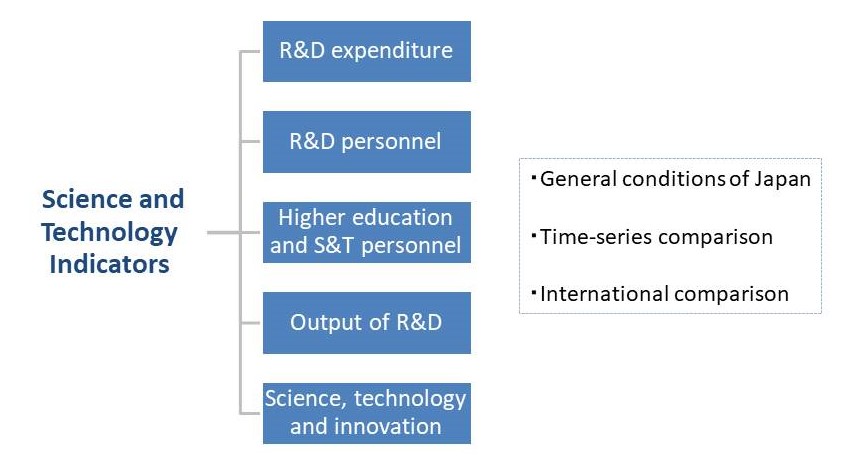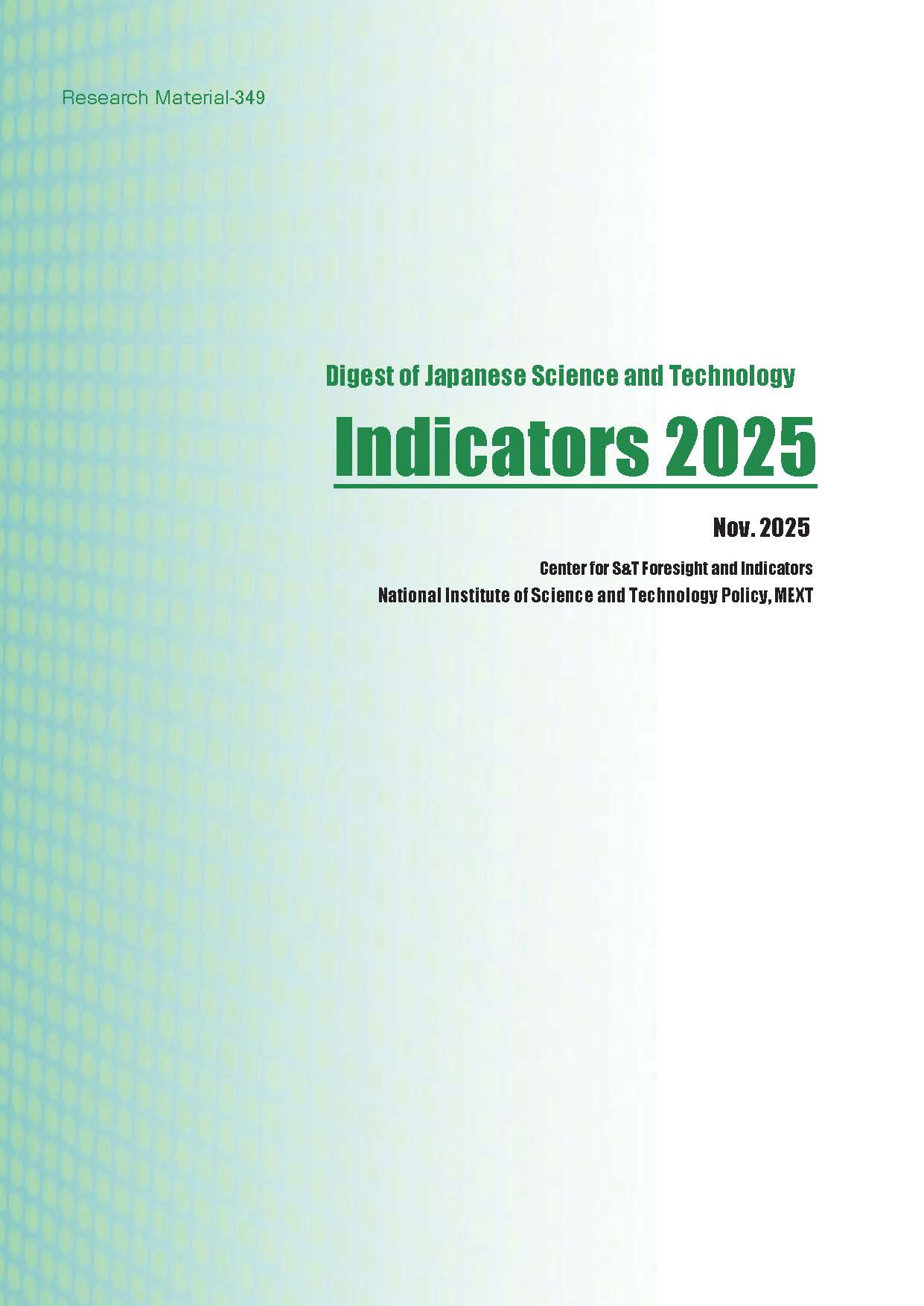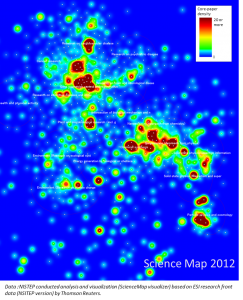
-
- Quantitative S&T data and their analysis are an indispensable foundation for formulating S&T policy, and they play an important role in S&T policy research. Quantitative data represent a key tool in grasping S&T activities that tend to be complex and reach across multiple fields, as well as in analyzing the effects and influences that policies have.
-
-
- Given that S&T activity is the process of producing knowledge, preparing
- quantitative data for this intangible process is not easy. In addition to this, close linkage to S&T activity with various other activities makes the measurement of S&T activity and differentiating it from other activities technically difficult. NISTEP understands the difficulties here, and that is why it is developing S&T indicators and conducting research in scientometrics in order to deepen application and analysis of quantitative S&T data.
-
Science and technology indicators
“Science and technology indicators” are basic resources for systematically ascertaining S&T activities in Japan and the world based on objective, quantitative data. Science and technology indicators are prepared by many countries of the world. In Japan, the first indicators were published by NISTEP in 1991. Initially, NISTEP reviewed the structures of indicator system every three years. However, since 2009, it has been emphasizing the timeliness of data by focusing on basic indicators that are updated each year. It assembles basic data that include R&D expenditure, number of researchers, and number of published research papers in Japan and major countries together with detailed explanations about meta-date of the statistics. Moreover, NISTEP not only announces “science and technology indicators” but also conducts relevant surveys and research.

Surveys and research
Reports on science and technology indicators

Since 2009, NISTEP has issued reports that, in principle, update data each year, with focus on items that allow time-series comparison as well as international comparison among major countries. NISTEP structures the reports to be as simple as possible. The report “Japanese Science and Technology Indicators 2025” covers five categories: “R&D Expenditure,” “R&D Personnel,” “Higher Education and S&T personnel,” “Output of R&D” and “S&T and Innovation.” Each presents circumstances in Japan using numerous related indicators.
- Digest of Japanese Science and Technology Indicators 2025(English ver.)[Research Material-349/2025.11]←NEW
- Digest of Japanese Science and Technology Indicators 2024(English ver.)[Research Material-341/2024.11]
- Digest of Japanese Science and Technology Indicators 2023(English ver.)[Research Material-328/2023.10]
- Digest of Japanese Science and Technology Indicators 2022(English ver.)[Research Material-318/2022.10]
- Digest of Japanese Science and Technology Indicators 2021(English ver.)[Research Material-311/2021.11]
- Digest of Japanese Science and Technology Indicators 2020(English ver.)[Research Material-295/2020.11]
- Digest of Japanese Science and Technology Indicators 2019(English ver.)[Research Material-283/2019.11]
- Digest of Japanese Science and Technology Indicators 2018(English ver.)[Research Material-274/2018.10]
- Digest of Japanese Science and Technology Indicators 2017(English ver.)[Research Material-261/2017.8]
- Digest of Japanese Science and Technology Indicators 2016(English ver.)[Research Material-251/2016.8]
- Digest of Japanese Science and Technology Indicators 2015(English ver.)[Research Material-238/2015.10]
- Japanese Science and Technology Indicators 2014(English ver.)[Research Material-229/2015.2](Digest PDF, Full HTML)
- Japanese Science and Technology Indicators 2013(English ver.)[Research Material-225/2014.2]
- Japanese Science and Technology Indicators 2012 (English ver.) [Research Material-214 / 2013.1]
- Japanese Science and Technology Indicators 2011 (English ver.) [Research Material-198 / 2011.8]
- Japanese Science and Technology Indicators 2010 (English ver.) [Research Material-187 / 2011.1]
- Japanese Science and Technology Indicators 2009 (English ver.) [Research Material-170 / 2010.2]
Research concerning science and technology indicators
NISTEP analyzed research time of university faculty members, an area where statistical analysis had been lacking despite its importance. NISTEP is also gathering information on methods for measuring R&D statistics and related statistics for major countries. These meta-data serve as the basis for the evaluation of international comparability of the S&T indicators.
- Shrinking Research Time for University Faculty Members Comparison of 2002 and 2008 in the Survey on Full-Time Equivalents at Universities [Discussion Paper No.80 / 2011.12]
- Metadata of R&D-related statistics in selected countries: Comparative study on the measurement methodology [Research Material-143 / 2007.10]
- Comparison of Science and Technology Indicator Systems with Their Histrical Development [Research Material-85 / 2002.3]
- Contribution to the Revision of “The Survey of Research and Development”- Reviews and Recommendations by NISTEP - [Research Material-79 / 2001.6]
To Library (List of Survey/Research Achievements)
Scientometrics
 As interest in evidence-based policymaking has been increasing in recent years, demands for accountability in R&D investment are growing stronger. As a result, understanding the outputs of R&D as well as the processes between investment and output has become an important research challenge. NISTEP seeks to take on this challenge by using a “scientometric” approach.
As interest in evidence-based policymaking has been increasing in recent years, demands for accountability in R&D investment are growing stronger. As a result, understanding the outputs of R&D as well as the processes between investment and output has become an important research challenge. NISTEP seeks to take on this challenge by using a “scientometric” approach.
Specifically, NISTEP focuses on scientific publications, patents, and other outputs of research activity to conduct quantitative analyses of R&D trends and S&T levels in Japan and abroad. The purpose here is to ascertain S&T trends panoramically and quantitatively.
Surveys and research
Scientometrics-based follow-up surveys on Science and Technology Basic Plans
The following scientometrics-based analyses, a part of follow-up surveys of the Third Science and Technology Basic Plan, were conducted by NISTEP:
- Comparative analysis of R&D inputs and outputs between Japan and major Countries [NISTEP REPORT No.118 / 2009.3]
- Analysis of the State of Japanese Universities System- Quantitative and Comparative study of research activity between Japan and UK And Research Environment study by Time budget survey -[NISTEP REPORT No.122 / 2009.3]
Science Map surveys to ascertain trends in international research
NISTEP generates maps of science, the Science Map, every other year to find out research areas that attracts international attention by analyzing highly cited papers (papers that ranked in the top 1% in terms of number of citations in each field). Examining these research fields reveals trends in international scientific research and qualitative changes in inter/multi-disciplinary research. It also shows that Japan’s share of hot research appearing on the Science Map is declining, and highlights differences between Japan and the United Kingdom and Germany, which are expanding their participation in hot research areas.
- Highlight of Science Map 2010 and Science Map 2012- Study on Hot Research Areas (2005-2010 and 2007-2011) by bibliometric method(English ver.) -[NISTEP REPORT No.159 / 2014.7]←New!!
- Science Map 2008- Study on Hot Research Areas(2003-2008)by bibliomethod (English ver.) - [NISTEP REPORT No.139 / 2010.5]
- Science Map 2006-Study on Hot Research Areas (2001-2006) by bibliometric method (English ver.) - [NISTEP REPORT No.110 / 2008.6]
- Science Map 2004-Study on Hot Research Areas (1999-2004) by bibliometric method (English ver.) - [NISTEP REPORT No.100 / 2007.3]
- The 8th Science and Technology Foresight Survey Study on Rapidly-developing Research Area[NISTEP REPORT No.95 / 2005.5]
Surveys for benchmarking Japan’s research activities based on comparison with major countries
NISTEP benchmarks Japan’s scientific research by focusing on scientific publications, which are the medium used to disseminate research activity results. Using individual indicators (i.e., number of papers published, number of adjusted top 10% papers, and number of citations) and composite indicators (i.e., share of adjusted top 10% papers in papers, and relative citation index), NISTEP compares circumstances in Japan with those major countries in individual fields. It also analyzes circumstances in Japan by sector and organizational classification, as well as time-series variations of paper production in Japan.
- Benchmarking Scientific Research 2012- Bibliometric Analysis on Dynamic Alteration of Research Activity in the world and Japan – [Research Material-218 / 2013.3]
- Benchmarking Scientific Research 2011- Bibliometric Analysis on Dynamic Alteration of Research Activity in the world and Japan – [Research Material-204 / 2011.12]
- Benchmarking Scientific Research 2010- Bibliometric Analysis on Dynamic Alteration of Research Activity in the world and Japan – [Research Material-192 / 2010.12]
- Benchmarking Research & Development Capacity of Japan Based on Dynamic Alteration of Research Activity in the World [Research Material-158 / 2009.8]
Benchmarking Research & Development Capacity of Japanese Universities
NISTEP benchmarks scientific research activities of Japanese universities to identify characteristics and strength of each university. The Research Activity Sheet of 128 Japanese universities is developed for analyzing their changing in characteristics and in time series, and compared them. NISTEP also conducts to show each university’s comparative position among its peers and to capture its world-class strength in each research field.
Joint Japan-US research: Analyses of knowledge creation process in science
NISTEP, Hitotsubashi University’s Institute of Innovation Research, and Georgia Institute of Technology conducted a large-scale survey on knowledge creation processes. The survey targeted scientists in Japan and the United States and received about 4,400 responses. The results of survey revealed the commonality and differences between Japan and the US in the knowledge creation in science.
- Knowledge Creation Process in Science: Key comparative findings from the Hitotsubashi-NISTEP-Georgia Tech scientists’ survey in Japan and the US (English ver.) [Research Material-203 / 2011.12]
- Knowledge Creation Process in Science:Basic findings from the large-scale survey of researchers in Japan (English ver.) [Research Material-191 / 2010.11]
Scientometrics-based trend analyses that focus on the engineering field
Engineering-oriented research is expected to play an important role in future innovation. Despite this, few detailed bibliometric analyses of such research have been available. NISTEP therefore conducts analyses of literature published by the Institute of Electrical and Electronics Engineers (IEEE), the world’s largest academic association. Based in the United States, IEEE publishes one-third of the world’s engineering literature and is highly influential in standardization and other activities. The aforementioned analyses allow NISTEP to clarify international researcher movements and changes in technical trends from its own unique vantage point.
- Quantitative Analysis on International Mobility of Researchers Based on Author Information-Robotics, Computer Vision and Electron Devices Research Domains as Subjects-[Research Material-199 / 2011.8]
- An Extensive Quantitative Analysis of IEEE Publications― Globalization of Electrical and Electronics Engineering Research ― [Research Material-194 / 2011.6]
- Evaluation on International Mobility of Researchers Using Author Record― A Case Study of Computer Vision Field ― [Discussion Paper No.61 / 2010.3]
- The Field Trends in IEEE Periodicals [Research Material-176 / 2010.2]
- The Worldwide TrendsIn the Fields of Electronics and Information & Communications- the Overiew of IEEE Periodicals(1992-2007) – [Research Material-169 / 2009.7]
Analyses concerning patents
NISTEP analyzes the characteristics of and changes in patent application trends for the world and major countries, with particular focus on patents that can be measured as outputs of research activity. It then reports the results as science and technology indicators. NISTEP also conducts the following analyses that target universities and public research institutions.
- A patent analyses of national universities in Japan [Discussion Paper No.67 / 2010.9]
- A Patent Portfolio of Universities and National Research Institutes by 8 S&T Priority Areas [Research Material-160 / 2008.11]
- A Study on University Patent Portfolios (2):The Impact of Intellectual Property Related Policies and the Change into Corporation of National University [Research Material-154 / 2008.6]
- A Study on University Patent Portfolios:Portfolio of Patent Application from Tohoku University [Research Material-147 / 2007.9]
Other scientometrics-based surveys and research
NISTEP also conducts analyses of specific fields, analyses that target developing countries, and analyses of industry-academia collaboration.
- An analysis on the relationship between input and output in the production of articles in universities-An approach using Web of Science and Survey of R&D [Discussion Paper No.89 / 2013.3]
- The Japanese Situation and Subjects of Health and Nutrition-related Research in the World: Country and Agency Rankings in Article Production [Discussion Paper No.72 / 2010.12]
- Analysis on Career Paths of the Most Highly Cited Scientists in Japan through International Comparison [Discussion Paper No.78 / 2010.9]
- Academic Entrepreneurship in Japanese Universities- Effects of University Interventions on Entrepreneurial and Academic Activities [Discussion Paper No.66 / 2010.8]
- Analysis on research activities in developing countries and international networking of researchers [Research Material-178 / 2010.3]
- Characteristics of excellent research activities:Report of survey on top-researchers’ activities and their views on effects of Japan’s science and technology policy and R&D status [Research Material-122 / 2006.3]
To Library (List of Survey/Research Achievements)
Notices
No notices are currently posted.
Links
No relevant links are currently posted.

